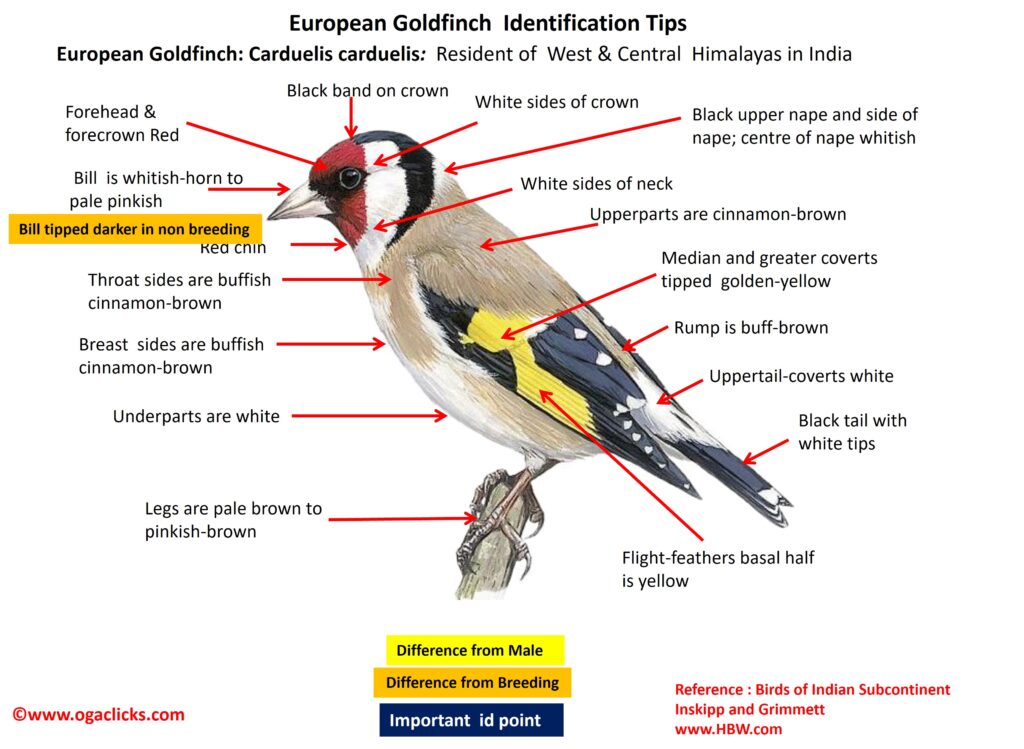
European Goldfinch Carduelis carduelis
Etymology:
- Carduelis : Latin word for the European goldfinch
- Carduelis : Latin word for the European goldfinch
Vernacular name: Kash: Shaira, Pun: Sunahri tooti
Distribution in India: Resident of Western & Central Himalayas in India .
Description: It has a size of 10·5–13·5 cm; wt. of 9·5–24 g. It is a small to medium-sized, brightly coloured finch with fine pointed bill and notched tail. The male nominate race has forehead and forecrown to just behind eye. The cheek and chin to upper throat are deep red, lores are black. The sides of crown down to side of neck and throat are broadly white, bordered by band of black on crown, upper nape and side of nape. The centre of nape is whitish or pale buff, becoming light sandy to cinnamon-brown on upperparts. The rump is paler buff-brown and uppertail-coverts white. The tail is black, feathers broadly tipped white, outermost two feathers broadly white on inner webs, large white spot on next inner feather. The upperwing is black, greater coverts broadly tipped golden-yellow, central feathers largely yellow. The flight-feathers are tipped white, broadly on secondaries. The basal half of secondaries and primaries are golden-yellow. The tertials are broadly tipped cream or white. The lower throat and side of breast to flanks are warm sandy or buffish cinnamon-brown, rest of underparts are white, tinged sandy-brown on undertail-coverts. The iris is dark brown or black; bill is whitish-horn to pale pinkish, tipped darker in non-breeding plumage. The legs are pale brown to pinkish-brown. The female is like male, but red on face less extensive, reaching back to anterior cheek and chin, red of chin more rounded patch and feathers often tipped black, black of crown mottled greyish-buff, side of head washed buffish and less extensively white; less white in outer two tail feathers, lesser and inner median coverts are fringed grey-brown, and buff-brown usually forming complete band across breast. The juvenile has head pale buffish-brown, finely streaked darker or blackish on crown, ear-coverts are faintly streaked darker, slightly warmer buff-brown upperparts also dark-streaked, more continuously so on mantle and scapulars, upperwing and tail as on adult, tips of median coverts, flight-feathers and tertials yellowish to buffish brown, yellow on greater coverts and bases of flight-feathers paler than on adult. The underparts are browner, with fine dark streaks on breast and flanks; red on face acquired through moult into first-winter plumage in Aug–Sept; first-winter and first-summer like adult, but slightly duller, with blackish-brown wings (some juvenile feathers often retained) and tail with buffish tips.
Habitat: It is found in open or sparse deciduous woodland and mixed deciduous and conifer woods, forest edges, thickets, heaths, hedgerows, stream, riverine and marshy areas with bushes and trees, roadside verges, steppe grasslands with scattered trees to edges of semi-desert areas, scrub, orchards, edges of cultivation, including fallow, rough and overgrown fields with tall vegetation, and parks and gardens. It is found 900m-2000m
Food habits: It eats seeds , buds, flowers and fruit of plants. It also eats some arthropods.The nestlings fed with insect larvae. Diet varies according to seasonal availability, insects eaten in early spring before most seeds available. It actively forages on ground, but mostly in or on plants, bushes and tall vegetation; often perches acrobatically on seed heads. It uses long, thin tweezer-like bill to picks seeds from exposed and hidden flower heads. It forages in pairs and in small flocks of up to 30 individuals; in non-breeding season often in larger flocks.
Breeding habits: They breed in Apr to early Aug. They have two broods. They are Monogamous. Solitary or loosely colonial, up to five nests in same tree. They are territorial, area of up to 250 m² used for mating and nesting, and forages up to 800 m beyond territory boundary. Pair formation takes place during late winter within flock, partners perch, either upright or crouching horizontally, showing red face and swinging body from side to side, wings slightly lowered and tail semi-spread, the two pivoting at different speeds, also repeated bill-touching by both and courtship-feeding of female by male, also short, vigorous chases initiated by either sex, chasing usually followed by perched pivoting display, singing and copulation (usually near nest-site); between chases either sex may adopt soliciting posture while perched horizontally, with wings drooped and shivered fairly vigorously and tail raised. The male also performs fairly brief slow-motion, stiff-winged display-flight with short glides, most often during nest building. The nest is built by female, male assist in collection of material. The nest is a compact small cup of grasses, moss, plant fibres and down feathers, cobwebs, animal hair and feathers, a few aromatic flowers on outside , concealed beneath foliage in outer twigs or slender branches of bush or tree. The material sometimes reused for second nest. They lay a clutch of 4–6 eggs. The incubation is done by female. The incubation period is 9–12 days. The chicks are fed and cared for by both parents. The nestling period is 13–18 days. The young are fed by parents for at least ten days after fledging.